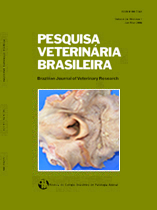 |
|
|
|
Year 2011 - Volume 31, Number 5
|

|
Clinical aspects and ruminal chemistry in goats with lactic acidosis and sodic monensin supplementation, 31(5):416-424
|
ABSTRACT.- Miranda Neto E.G., Silva S.T.G., Mendonça C.L., Drummond A.R.F. & Afonso J.A.B. 2011. [Clinical aspects and ruminal chemistry in goats with lactic acidosis and sodic monensin supplementation.] Aspectos clínicos e a bioquímica ruminal de caprinos submetidos à acidose láctica experimental e suplementados ou não com monensina sódica. Pesquisa Veterinária Brasileira 31(5):416-424. Clinica de Bovinos, Universidade Federal Rural de Pernambuco, Cx. Postal 152, Garanhuns, PE 55292-901, Brazil. E-mail: eldinemneto@hotmail.com
The aim of the present study was to analyze clinical and laboratory findings regarding goats submitted to the incorporation of monensin in their feed and assess its effects on the prevention of experimentally induced ruminal lactic acid. Clinical aspects as well as physiochemical and microbiological characteristics of the ruminal fluid were assessed. Twenty clinically healthy, castrated, male, mixed-breed goats with a mean weight of 30kg were used, in which permanent ruminal cannulae were implanted. Two groups of ten animals were formed: A control group (CG) and a group that received 33mg/kg of monensin (GM) per animal in the diet for 40 days. Ruminal acidosis was induced by administering 10g of sucrose/kg of live weight, prior to the morning meal. Clinical observations and the collection of ruminal fluid were carried out at 4, 8, 12, 24, 32, 48 and 72h post-induction (PI). At 4 hours PI, there were signs of apathy, capricious appetite or anorexia, tachycardia, tachypnea, rumen stasis, abdominal distention and diarrhea of varying severity. The reflux of rumen fluid through the nostrils, signs of colic intestinal and serous bilateral nasal discharge was observed in some animals of the CG, and laminitis in GM. There was an average loss of body weight of 900g in CG (P>0.05) and 1.3kg in GM (P<0.05). There was a significant decrease (P<0.05) rumen pH falls below six; uptime sedimentation and flotation, viability, motility and density of protozoan, as of four hours of induction in GC and four to 24 hours in GM, the number of infusers, at 4 PI, both in CG and GM, which remained until the end of 72 hours, and the values of acetic, propionic and butyric acids in GM. The values of butyric acid in the GC reduced there is not significant difference (P>0.05). The color of the rumen fluid became milky, acid smell and watery consistency. There was a significant increase (P <0.05) the acidity, of the test time reduction of methylene blue, the values of chloride and lactic acid. The dynamics of the fauna and flora has changed, with a predominance of Gram-positive. In some animals there was no full restoration of all variables. The use of monensin did not prevent the onset of the disorder fermentation in animals that received. |
| |
|
|
| |
|
 |